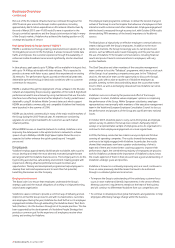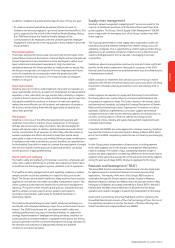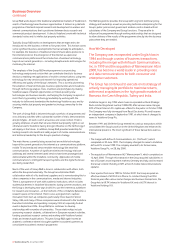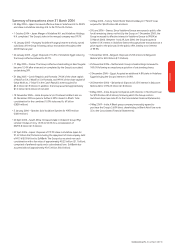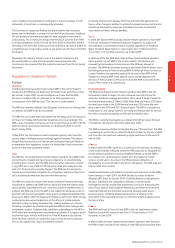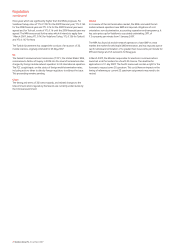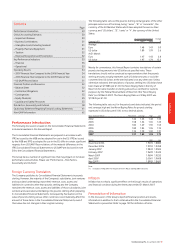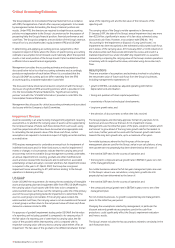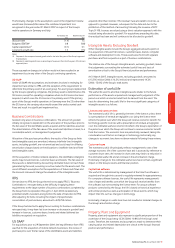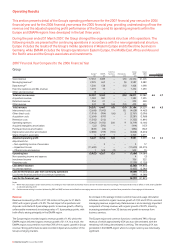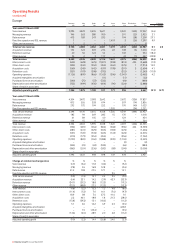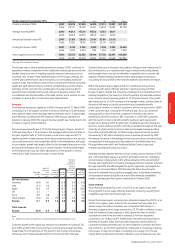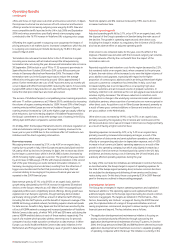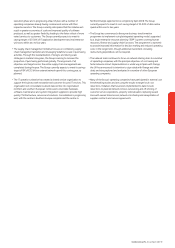Vodafone 2007 Annual Report Download - page 32
Download and view the complete annual report
Please find page 32 of the 2007 Vodafone annual report below. You can navigate through the pages in the report by either clicking on the pages listed below, or by using the keyword search tool below to find specific information within the annual report.30 Vodafone Group Plc Annual Report 2007
Critical Accounting Estimates
The Group prepares its Consolidated Financial Statements in accordance
with IFRS, the application of which often requires judgements to be made
by management when formulating the Group’s financial position and
results. Under IFRS, the directors are required to adopt those accounting
policies most appropriate to the Group’s circumstances for the purpose of
presenting fairly the Group’s financial position, financial performance and
cash flows. The Group also prepares a reconciliation of the Group’s revenue,
net profit or loss and shareholders’ equity between IFRS and US GAAP.
In determining and applying accounting policies, judgement is often
required in respect of items where the choice of specific policy, accounting
estimate or assumption to be followed could materially affect the reported
results or net asset position of the Group should it later be determined that
a different choice would be more appropriate.
Management considers the accounting estimates and assumptions
discussed below to be its critical accounting estimates and, accordingly,
provides an explanation of each below. Where it is considered that the
Group’s US GAAP accounting policies differ materially from the IFRS
accounting policy, a separate explanation is provided.
The discussion below should also be read in conjunction with the Group’s
disclosure of significant IFRS accounting policies, which is provided in note
2 to the Consolidated Financial Statements, “Significant accounting
policies” and with the “US GAAP information” provided in note 38 to the
Consolidated Financial Statements.
Management has discussed its critical accounting estimates and associated
disclosures with the Company’s Audit Committee.
Impairment Reviews
Asset recoverability is an area involving management judgement, requiring
assessment as to whether the carrying value of assets can be supported by
the net present value of future cash flows derived from such assets using
cash flow projections which have been discounted at an appropriate rate.
In calculating the net present value of the future cash flows, certain
assumptions are required to be made in respect of highly uncertain matters,
as noted below.
IFRS requires management to undertake an annual test for impairment of
indefinite lived assets and, for finite lived assets, to test for impairment if
events or changes in circumstances indicate that the carrying amount of
an asset may not be recoverable. Group management currently undertakes
an annual impairment test covering goodwill and other indefinite lived
assets and also reviews finite lived assets and investments in associated
undertakings at least annually to consider whether a full impairment review
is required. In the year to 31 March 2007, the Group has recognised
impairment losses amounting to £11,600 million relating to the Group’s
operations in Germany and Italy.
US GAAP
Under US GAAP, the requirements for testing the recoverability of intangible
assets and property, plant and equipment differ from IFRS. US GAAP requires
the carrying value of such assets with finite lives to be compared to
undiscounted future cash flows over the remaining useful life of the primary
asset of the asset group being tested for impairment, to determine if the
asset or asset group is recoverable. If the carrying value exceeds the
undiscounted cash flows, the carrying value is not recoverable and the asset
or asset group is written down to the net present value of future cash flows
derived in a manner similar to IFRS.
For purposes of goodwill impairment testing under US GAAP, the fair value
of a reporting unit including goodwill is compared to its carrying value. If
the fair value of a reporting unit is lower than its carrying value, the fair
value of the goodwill within that reporting unit is compared with its
respective carrying value, with any excess carrying value written off as an
impairment. The fair value of the goodwill is the difference between the fair
value of the reporting unit and the fair value of the net assets of the
reporting unit.
The carrying value of the Group’s mobile operations in Germany at
31 January 2007, the date of the Group’s annual impairment test, was more
than £25 billion, significantly in excess of its fair value, estimated using
discounted cash flows. However, in accordance with SFAS No. 144,
“Accounting for the Impairment or Disposal of Long-Lived Assets”, no
impairment has been recognised as the estimated undiscounted cash flows
are in excess of the carrying value. At 31 January 2007, a 16.0% reduction in
the undiscounted cash flows would eliminate this excess and result in a
material impairment loss under US GAAP. Any impairment loss would be
measured by comparing the carrying value of the Group’s mobile operations
in Germany with its respective fair value, estimated using discounted cash
flows.
Assumptions
There are a number of assumptions and estimates involved in calculating
the net present value of future cash flows from the Group’s businesses,
including management’s expectations of:
•growth in EBITDA, calculated as adjusted operating profit before
depreciation and amortisation;
•timing and quantum of future capital expenditure;
•uncertainty of future technological developments;
•long term growth rates; and
•the selection of discount rates to reflect the risks involved.
The Group prepares and internally approves formal ten-year plans for its
businesses and uses these as the basis for its impairment reviews.
Management uses the initial five years of the plans, except in markets which
are forecast to grow ahead of the long term growth rate for the market. In
such cases, further years will be used until the forecast growth rate trends
towards the long term growth rate, up to a maximum of ten years.
For mobile businesses where the first five years of the ten year
management plan are used for the Group’s value in use calculations, a long
term growth rate into perpetuity has been determined as the lower of:
•the nominal GDP rates for the country of operation; and
•the long term compound annual growth rate in EBITDA in years six to ten
of the management plan.
For mobile businesses where the full ten year management plans are used
for the Group’s value in use calculations, a long term growth rate into
perpetuity has been determined as the lower of:
•the nominal GDP rates for the country of operation; and
•the compound annual growth rate in EBITDA in years nine to ten of the
management plan.
For non-mobile businesses, no growth is expected beyond management’s
plans for the initial five year period.
Changing the assumptions selected by management, in particular the
discount rate and growth rate assumptions used in the cash flow
projections, could significantly affect the Group’s impairment evaluation
and, hence, results.
The Group’s review includes the key assumptions related to sensitivity in the
cash flow projections.


